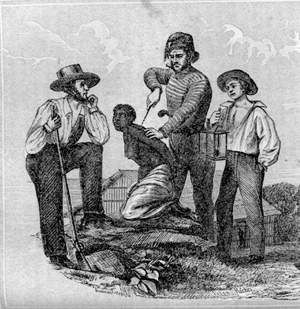The Changing Resource of Labor
Resources, Not Assets
Whenever a client refers to their employees as assets, I am quick to admonish them for their poor choice of words. Sometimes I can be harsh. "Do you mean to tell me that you actually bought your employees, like you would buy a machine?"
Sometimes I get a blank look of incomprehension; they do not know the true meaning of the word asset. Sometimes the person blushes with embarrassment while he thinks about the meaning of the word asset. Sometimes they say defensively, "But they are our most important asset." This kind of comment comes from someone who just does not get it.
Companies refer to their employees as their most important asset all the time. Business magazines quote CEOs making the statement, “Our people are our greatest asset.” You can find it on their web sites, usually on their "careers" page.
I've had bosses tell me that I was a great asset. You know, they pissed me off every time they said that.
Here is the evil of the imprecise use of these terms. When a leader says “Our people are our greatest asset,” it sounds like they really care. It sounds as if the management of those companies truly believes that the people within their organization are their most important assets. It sounds like these leaders really believe that their people are the most important part of the business.
 It sounds like that, but is it really what they believe? When you stop to really think about the definition of an asset, does a different image comes to mind?
It sounds like that, but is it really what they believe? When you stop to really think about the definition of an asset, does a different image comes to mind?
Perhaps the only time that people are an asset is when you go looking at the stock photos that so many companies use on their websites to illustrate that they have people working in the company. Let me ask you, how many times have you gone looking at a logistics, transportation, software, or consulting services company and seen these same people smiling from the screen? The older guy with the glasses and friendly power-boss smile; that guy works for over thirty different companies, judging from the web sites I’ve looked at in just the past six months!
I captured these photos from three different consulting websites in the past month.
 I think the older guy is not the only job hopper; it looks like the whole crew is a group of mercenaries. Heck, they don't even change their clothes!
I think the older guy is not the only job hopper; it looks like the whole crew is a group of mercenaries. Heck, they don't even change their clothes!
Does the illusion of a staff make you feel any more confident of the service the company provides? Or would you, as a buyer of goods and services, rather look at photos of the actual people who work for the company? A simple observation on my part: the consulting companies that use the stock photo assets in their promotional material and websites tend to look at their clients as assets, and the people who work for the clients as assets. The companies that show their actual people look at those people as resources—the people that actually generate and serve the business.
Who would you rather work with?
 People Are Resources, Not Assets
People Are Resources, Not Assets
An asset is anything that has exchange value. An asset is owned.
Are you a thing? Are you, as a human being, something that can be bought or sold?
Can you be owned?
In the US we fought a long and bloody civil war more than a century ago to end the practice of slavery.  Until Abraham Lincoln abolished slavery with the Emancipation Proclamation, it was possible for an individual to own another human being as an asset. After Lincoln signed that executive order on January 1, 1863, a business or individual could no longer own another human being.
Until Abraham Lincoln abolished slavery with the Emancipation Proclamation, it was possible for an individual to own another human being as an asset. After Lincoln signed that executive order on January 1, 1863, a business or individual could no longer own another human being.
You could say that on January 1, 1863, “Employment at Will” became the law of the land.
Can You Be Owned?
If you think about it, the answer is, “It depends.” Depends? Depends on what?
It depends on whether you allow it, and whether society allows it. In the years leading up to the US Civil war, in some states, the culture of the society did not allow slavery. The culture of the people in those states decided that slavery was abhorrent, something they wanted to abolish. The abolitionists in those states attempted, through political methods, to change the behavior of the culture in the states that allowed slavery. As was to be expected, the slave-owning people of the slave states resented the efforts of the abolitionists to change the slave state culture.
Where the culture of the society allows a behavior, it is harder to resist the behavior. Our culture in the US used to find smoking attractive. Because the culture found it attractive, people smoked. As the culture discovered that smoking was a sure way to shorten your life, the culture turned against the practice. There are still smokers in the US today, but the culture continues to ostracize the smoker. As the culture changed, it became easier for smokers to decide to change. Truly addicted smokers now have different ways to break the chains that enslave them to the habit.
When a culture supports a behavior, it is harder for an individual to break free. It is much harder for a group to break free. Prior to the US Civil War, individual slaves, or small groups of slaves, would risk capture to escape to free states. The society of the slave states reinforced the culture by capturing and returning slaves to their owners. Plantation owners could count on their society to help put down slave rebellions with violent and deadly measures.
Our culture and society does have examples today of organizations that own people as assets. Look at the world of team sports, and you have an example of where our culture allows this behavior. Athletes have freedom of choice; they can choose to play the game or not. Players have the choice to sign with a team, or not. Nevertheless, once a player signs a contract, a team can trade that player to another team, and the player must go.
How can you be owned? When you choose to be owned.
Wage Slaves
Employees work for a company, and do so of their own free will. They are free to quit and move on. That argument is often countered with stories of people who can’t quit their job and move on because other jobs do not exist, or they can’t get health coverage. The story goes that people can’t move on because they are trapped by the economic and social conditions in which they live.
What a rationalization. How many wage-slaves are in a position where they are trapped, chained to their desk because they are paid more for what they do than the alternatives? How many times have you heard a well-paid co-worker complain about their job? How many times have you complained?
Companies do not own their employees. Still, many companies act as if they do own their employees. They see their employees as adversaries, as stupid cows who must be herded and cajoled to be productive. Managers sometimes treat their employees with contempt, and are in turn held in contempt by their employees.
If I had a dollar for every time I heard a manager talk about how their boss held them in contempt, I would have a nice pile of cash.
The storyline goes that management hates the employee. They have for years. Managers look down upon the working man, holding them in contempt. That attitude, that contempt, is what brought about labor unions. Over time, the unions forced management to change.
At least that is what the unions would like us to believe. Unions did bring social change. Early labor laws reflected changes in the culture of the country. The first institution to fall was child labor. The next culture change focused on long working hours. The first labor union battles were fought over working hours, in an attempt to cap the working day at eight hours in a shift. Once management made the workday concessions, the unions went for increased wages.
Union work rules continued to intrude into the details of how the shop floor operated. Management and union leaders fought at the local level. The work rules changed to the point that managers were no longer allowed to touch tools, to do the work of the skilled laborers. Further, the unions defined job classifications, making it so that only specific workers could do specific work. In some shops managers became fearful of the unions, of the power the union had to shut down the production of a plant.
Not too long ago, I was doing some work in a union shop. Tension was painted on every surface. Almost nothing penetrated the minds or opinions of the managers or the employees. Trust was like dust, it blew around in the breeze. One of the most interesting dynamics was not the trust between managers and employees (there was none), but the lack of trust the employees had for each other. The employees did not want to be overheard by other employees, concerned about who would "narc" to the union boss. Even when a conversation would loosen up, the air would chill when the shop steward came into view.
Who Owns Whom?
Once a social issue is solved, what is there to do? Perhaps there is an ongoing need for tension between unions and managers? But why?
I think that in some union environments (not all), the ownership of labor changed. Now the union owns the workers, and the managers of the company buy the services. This gets played out in many a union shop today, where the union decides who works in the shop, and who is paid for no work. Managers can fight to have a bad worker removed, but often under the threat of strike or other actions, and the problem employee still gets to collect a paycheck. This is not new; the problem of unions protecting bad workers has been with us for some time. But perhaps we are starting to see union members taking back the leadership of their organizations.
It all comes down to power. Who has it and who doesn't. Those with power get to call the shots and pay themselves. Those without don't.


